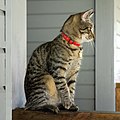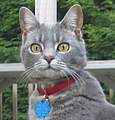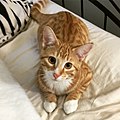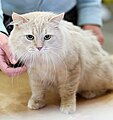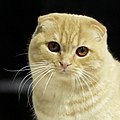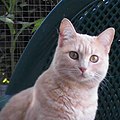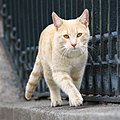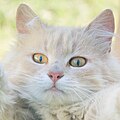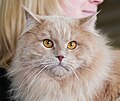Tabby cat color overview
Attention[edit]
- All tabby colours can occur as tortoiseshell tabbies. In these coats the base tabby colour is mixed with red-orange tabby parts, or cream tabby parts for diluted colourations (blue, lilac, fawn).
- Solid white areas can be mixed with all tabby coats. On paws the white areas will result in pink footpads, white areas around the nozzle will turn the nose pink-red. Similar to solid-white cats. See also: Tabby and white cats.
- All tabby colours can occur in combination with the silver or golden genes (see also Silver and golden cats for examples), which presents as effects on the pigment colouration at the base/root of each hair rather than a separate colour. The tip of the hairs will still have the main tabby colours.
- Kittens can have lighter or different colourings and/or faint tabby patterns, because the coat is not fully developed yet.
- Ambient light can influence the appearance of the coat colouration in pictures.
- The colours can present differently in different breeds and in colourpoint markings. Additionally, sunlight can lighten the fur pigmentation over time.
- There are more colours possible, that are not included in this list. See also: Rare cat color overview. These type of rare colours and colour dilutions are more likely to appear in pedigree or purebred cats that have been specifically bred for their colouration.
Black, brown, and blue tabbies[edit]
Black / brown tabbies[edit]
Black or brown tabbies have black/brown markings on a grey to brown-coloured background. Their footpads are dark coloured and the hairs between the pads are black/brown coloured. This is the most common colouration in tabby cats. It is the wild-type or agouti fur coat in cats. See also Silver and golden cats for examples of black silver and black golden tabby cats.
Blue tabbies[edit]
Blue tabbies have (dark) grey-bluish markings on a beige-coloured background. Blue is the diluted version of black/brown. Blue tabbies will have pink/purple footpads and grey hairs between the pads. Often the tabby markings are nearly the same colour as the background, therefore it can be difficult to distinguish and categorise the tabby pattern. See also Silver and golden cats for examples of blue silver and blue golden tabby cats.
Red, orange, and cream tabbies[edit]
Red tabbies[edit]
Red tabbies (also called orange, marmalade, ginger and sandy) have red/orange markings on a off-white to orange-coloured background. There are no true solid/self coloured red cats; even genetically solid red cats will have tabby markings.
Cream tabbies[edit]
Cream tabbies have cream or buff markings (pale/faint yellow-orange with a pinkish teint) on a off-white to pale honey-coloured background. Cream is the diluted version of red/orange. There are no true solid/self coloured cream cats; even genetically solid cream cats will have tabby markings. Cream tabby cats do not have any orange-red tabby markings, the darkest colour in the fur is cream (pale/faint yellow-orange with a pinkish teint). Typically the cream tabby markings are nearly the same colour as the background, therefore it can be difficult to distinguish and categorise the tabby pattern.
-
Bicolour
-
Colourpoint



